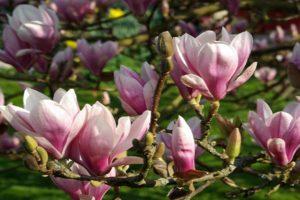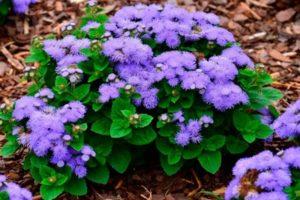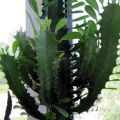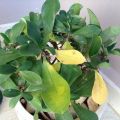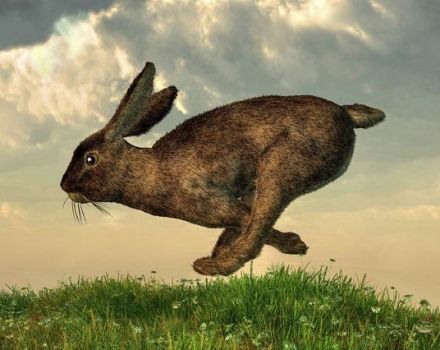Reproduction, planting and care of Milkweed Milk at home
Euphorbia Mila is a beautiful ornamental exotic plant. Introduced almost 2 centuries ago from Africa, thanks to its unpretentiousness, resistance to moisture deficiency, low susceptibility to diseases and pests, this species has become one of the most beloved indoor plants of both experienced flower growers and amateurs.
Breeding history of the variety
The homeland of this culture is the mountainous regions of Madagascar and the adjacent islands. This Madagascar species of milkweed is also widespread in South Africa and Mexico. For the first time in Europe, this plant was brought by the governor of the French island of Reunion - Baron Milus, in 1821. Originally, this type of milkweed, due to its tallness and sharp thorns, was used for dense hedges. But over time, because of the long and beautiful flowering, they began to cultivate it as an ornamental plant, to decorate winter gardens, greenhouses.
On a note. Due to the characteristic shine of the leaves, as well as the large number of thorns, this plant also received such characteristic names as euphorbia and Crown of Thorns.
Botanical description and culture features
Euphorbia Mila is an indoor flower already familiar to most housewives. It is distinguished from other species of the Euphorbia family, first of all, by its characteristic features in the structure of vegetative and generative organs.
Stem
The plant has an erect, highly branched, slightly ribbed stem of a grayish color with a large number of sharp lignified thorns. In nature, this species of milkweed reaches a height of 200 centimeters, in room conditions - 100-120 centimeters.
Leaves
The plant has light green elliptical or teardrop-shaped leaves, up to 50 millimeters long and 15 millimeters wide. They are formed on the tops of the central and lateral shoots. At the same time, each leaf blade has 2 modified stipules - sharp thorns, which, after the death of the leaf, remain on the stem.

Bloom
With proper care, this spurge can bloom all year round. The flowers of this plant are inconspicuous, small, yellowish, surrounded by large bracts of scarlet, white, yellow color.
Important. Very often, many flower growers ask themselves why this unpretentious type of milkweed does not bloom in them.The answer lies in improperly organized care - inadequate lighting, rare top dressing, strong growth of lateral shoots, which take away a large amount of nutrients from the soil for their growth and development.
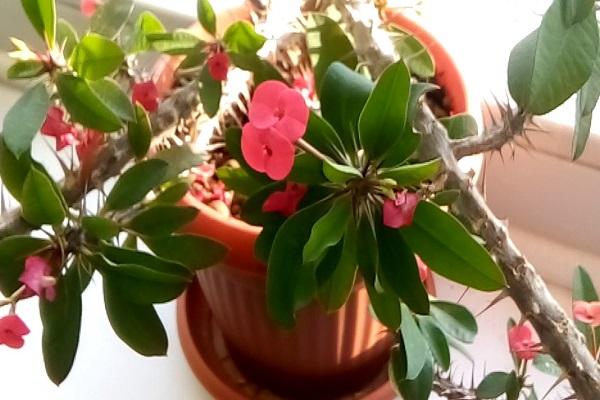
Reproduction
Milkweed is propagated in the following ways:
- Seeds - for this, seeds bought in a store are sown in small containers with a light nutritious substrate, covered with a film or sheet glass, and placed in a warm and dark place. After the sprouts appear, the container is placed on a well-lit windowsill. When 2-3 true leaves are formed in seedlings, they are dived into separate pots.
- Cuttings - a 10-12-centimeter stalk with 2-3 leaves is cut from the top of the shoot when pruning, placed in a container of water for a day, after which its lower cut is powdered with charcoal, kept for another 2-3 days, and only then planted in a small pot or glass filled with a light nutrient medium (coarse sand). The process of rooting and the formation of a normal root system takes, on average, 30-45 days.
Of these two methods, cuttings are most often used - it allows you to save money on the purchase of expensive seeds and, with a high probability, get a strong seedling with fully preserved varietal characteristics.
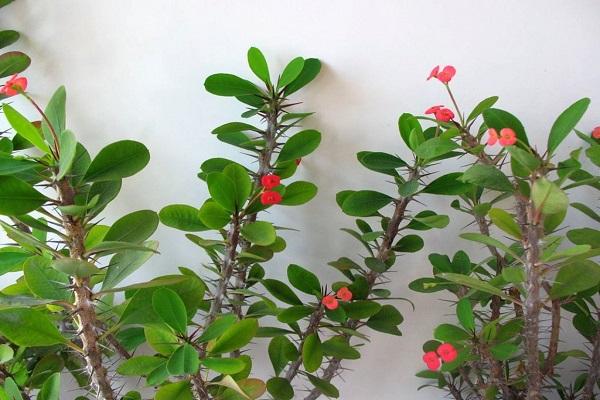
Pests of the shiny
The main pests of milkweed are aphids, whitefly and root mealybug.
Aphids
These pests, settling in whole colonies on the leaves, suck out the juice from them, because of which the leaf blades curl, turn yellow prematurely and fall off. They fight aphids on milkweed, cutting off damaged shoots, spraying plants with insecticides such as Actellik, Aktara, Inta-Vir.
Whitefly
Whiteflies are small white flies that settle on the underside of leaves and feed on their sap. The leaves affected by the pest curl, turn yellow, and fall off. To combat whitefly, the leaves infested with pests are removed, and the plants are sprayed with insecticides.

Root mealybug
This pest settles in the soil and damages the delicate young roots of the plant, thereby leading to a slowdown in its growth, and with a large population - to death. To combat the mealybug, the affected plant is removed from the pot, its root system is thoroughly cleaned of soil, washed under water, sprayed with insecticides and transplanted into a new, previously disinfected container. The old pot is thrown away.
Milkweed disease
Of the diseases, Mila's euphorbia damages only rot, which is the result of frequent and abundant watering, low temperature in the room. To eliminate the consequences of this disease, the plant is taken out of the waterlogged substrate, the roots are thoroughly disinfected, rotten shoots are removed and, transplanted into a new container, they are placed in a room with a normal temperature regime.
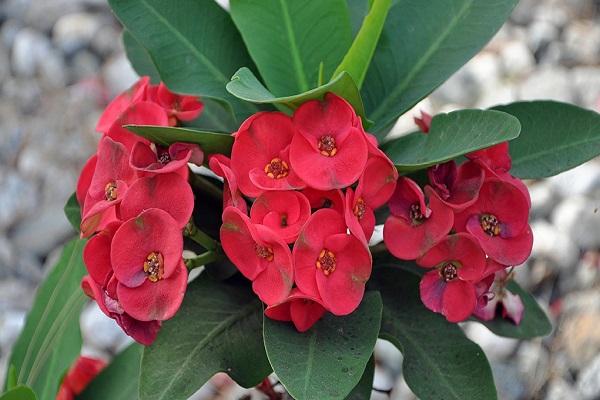
Necessary conditions for growing
For normal growth and development, even such a plant that is unpretentious to conditions, such as the Milkweed, needs a certain level of illumination, the composition of the nutrient substrate, and air humidity.
Location and lighting
The container with the plant is placed on well-lit, south-facing windows. In winter, with insufficient lighting, supplementary lighting with special lamps is used for normal and abundant flowering. Insufficient illumination will lead to the fact that the plant will stretch out strongly, will cease to bloom profusely and beautifully.
Air humidity
Euphorbia is not picky about air humidity and does not need additional humidification. This plant feels good in the dry and hot air of apartments and private houses with stove or central heating.
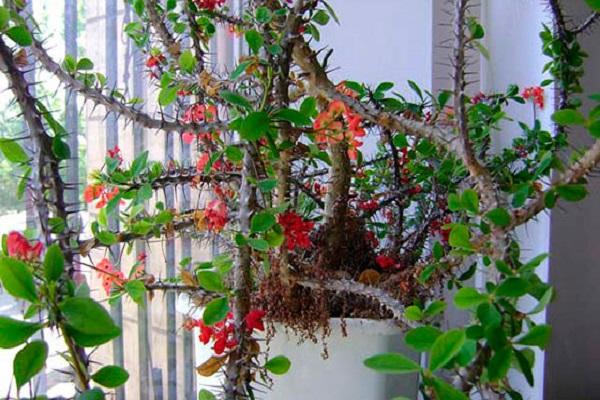
Soil requirements
The most suitable soil in terms of physical and chemical properties for growing Milkweed is a special store soil for succulents and cacti. In the absence of the possibility of acquiring such a soil for planting milkweed, a soil mixture is prepared, consisting of equal parts of leaf and sod land, peat, and coarse sand.
Optimal temperature conditions
The optimal temperature regime in the room in which Milkweed is grown depends on the time of the years:
- Summer - + 20, +25 FROM.
- In winter - +15, +16 FROM.
With a temperature background below these values, the plant will be strongly oppressed, prematurely shed its leaves, and not form pedicels with buds.

Planting a flower at home
At home, this type of milkweed is grown in seedlings, with the obligatory picking of grown seedlings.
Tank and soil preparation
For planting seeds, use ordinary seedling boxes, previously cleaned of last year's soil residues and disinfected with a 1% solution of potassium permanganate. A light mixture for succulents or the homemade mixture described above is poured into them, spilled with water.
For picking grown seedlings, shallow and wide pots with holes at the bottom and a layer of drainage from expanded clay and pebbles are used. The drainage should take up about 1/3 of the tank volume.
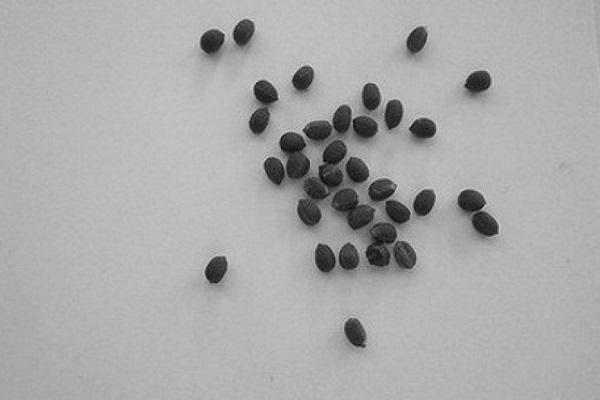
Technological process of disembarkation
Seeds are planted in small grooves in the soil substrate, covered with top and, covering the seedling box, placed in a dry, warm and dark room. After the sprouts appear, the seedlings are grown in a box until they have 3 true leaves. After that, the seedlings dive into separate containers prepared in advance.
How to care for a plant
Milkweed care includes watering the plants, feeding and occasional pruning.

Watering frequency
This plant belongs to succulents - crops with high drought tolerance. Thanks to this, Mila spurge does not require abundant and frequent watering. The frequency of watering depends on the season:
- In the summer, the plant is watered once a week.
- In spring and autumn - once every 14-15 days.
- In winter - once a month.
Water the plant with settled soft water at room temperature. When watering, water is carefully poured under the root, preventing it from falling on the stems and leaves.
Do I need to spray the bush
Milk milkweed leaves should not be sprayed - this can lead to the formation of foci of rot, the appearance of pests. The dust layer formed on the leaf blade is removed with a small brush or soft cloth.
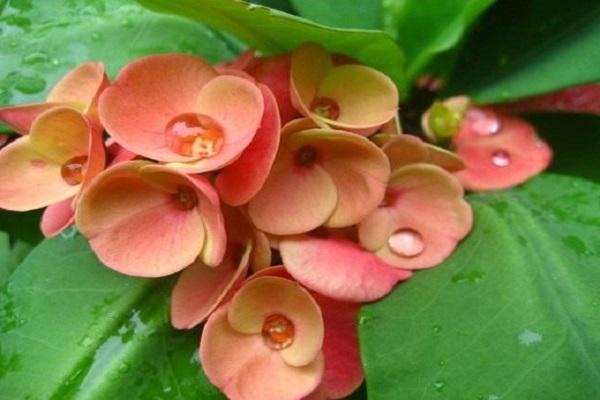
How often and what to feed
The plant is fed when it is watered, with a special liquid complex fertilizer for cacti and other succulents. The frequency of feeding in the spring-autumn period is 1 time per month.
Formation
In order for the spurge to please with abundant and beautiful flowering, it must be cut off annually. With this pruning, all the shoots of the plant are shortened by about half their length.
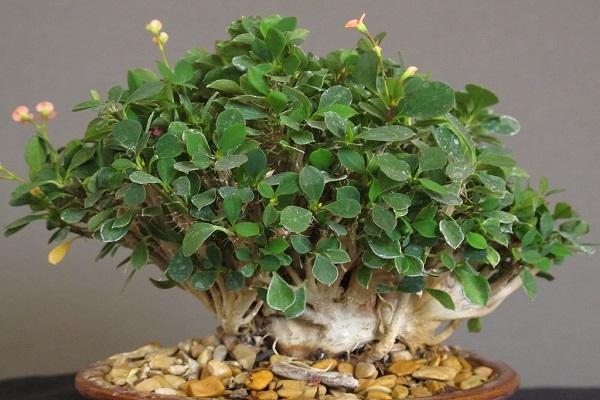
Transfer
Since in the course of growth and development, the plant develops not only the aerial part, but also the root system, it must be periodically transplanted in a larger container. The frequency of transplants depends on the age of the plants: young plants are transplanted once a year, adults - once every 2-3 years.
